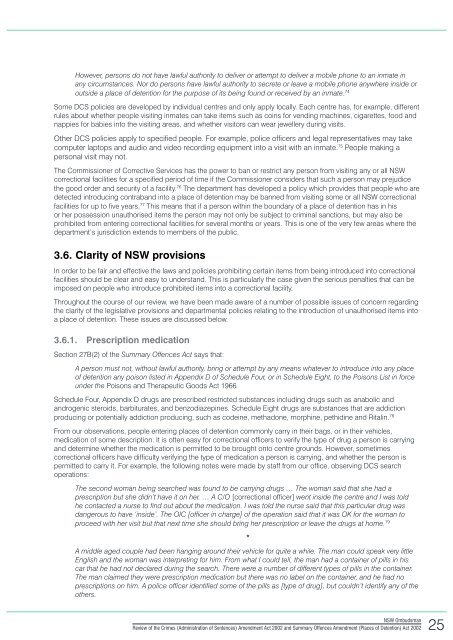Administration of Sentences - NSW Ombudsman - NSW Government
Administration of Sentences - NSW Ombudsman - NSW Government
Administration of Sentences - NSW Ombudsman - NSW Government
You also want an ePaper? Increase the reach of your titles
YUMPU automatically turns print PDFs into web optimized ePapers that Google loves.
However, persons do not have lawful authority to deliver or attempt to deliver a mobile phone to an inmate in<br />
any circumstances. Nor do persons have lawful authority to secrete or leave a mobile phone anywhere inside or<br />
outside a place <strong>of</strong> detention for the purpose <strong>of</strong> its being found or received by an inmate. 74<br />
Some DCS policies are developed by individual centres and only apply locally. Each centre has, for example, different<br />
rules about whether people visiting inmates can take items such as coins for vending machines, cigarettes, food and<br />
nappies for babies into the visiting areas, and whether visitors can wear jewellery during visits.<br />
Other DCS policies apply to specified people. For example, police <strong>of</strong>ficers and legal representatives may take<br />
computer laptops and audio and video recording equipment into a visit with an inmate. 75 People making a<br />
personal visit may not.<br />
The Commissioner <strong>of</strong> Corrective Services has the power to ban or restrict any person from visiting any or all <strong>NSW</strong><br />
correctional facilities for a specified period <strong>of</strong> time if the Commissioner considers that such a person may prejudice<br />
the good order and security <strong>of</strong> a facility. 76 The department has developed a policy which provides that people who are<br />
detected introducing contraband into a place <strong>of</strong> detention may be banned from visiting some or all <strong>NSW</strong> correctional<br />
facilities for up to five years. 77 This means that if a person within the boundary <strong>of</strong> a place <strong>of</strong> detention has in his<br />
or her possession unauthorised items the person may not only be subject to criminal sanctions, but may also be<br />
prohibited from entering correctional facilities for several months or years. This is one <strong>of</strong> the very few areas where the<br />
department’s jurisdiction extends to members <strong>of</strong> the public.<br />
3.6. Clarity <strong>of</strong> <strong>NSW</strong> provisions<br />
In order to be fair and effective the laws and policies prohibiting certain items from being introduced into correctional<br />
facilities should be clear and easy to understand. This is particularly the case given the serious penalties that can be<br />
imposed on people who introduce prohibited items into a correctional facility.<br />
Throughout the course <strong>of</strong> our review, we have been made aware <strong>of</strong> a number <strong>of</strong> possible issues <strong>of</strong> concern regarding<br />
the clarity <strong>of</strong> the legislative provisions and departmental policies relating to the introduction <strong>of</strong> unauthorised items into<br />
a place <strong>of</strong> detention. These issues are discussed below.<br />
3.6.1. Prescription medication<br />
Section 27B(2) <strong>of</strong> the Summary Offences Act says that:<br />
A person must not, without lawful authority, bring or attempt by any means whatever to introduce into any place<br />
<strong>of</strong> detention any poison listed in Appendix D <strong>of</strong> Schedule Four, or in Schedule Eight, to the Poisons List in force<br />
under the Poisons and Therapeutic Goods Act 1966.<br />
Schedule Four, Appendix D drugs are prescribed restricted substances including drugs such as anabolic and<br />
androgenic steroids, barbiturates, and benzodiazepines. Schedule Eight drugs are substances that are addiction<br />
producing or potentially addiction producing, such as codeine, methadone, morphine, pethidine and Ritalin. 78<br />
From our observations, people entering places <strong>of</strong> detention commonly carry in their bags, or in their vehicles,<br />
medication <strong>of</strong> some description. It is <strong>of</strong>ten easy for correctional <strong>of</strong>ficers to verify the type <strong>of</strong> drug a person is carrying<br />
and determine whether the medication is permitted to be brought onto centre grounds. However, sometimes<br />
correctional <strong>of</strong>ficers have difficulty verifying the type <strong>of</strong> medication a person is carrying, and whether the person is<br />
permitted to carry it. For example, the following notes were made by staff from our <strong>of</strong>fice, observing DCS search<br />
operations:<br />
The second woman being searched was found to be carrying drugs … The woman said that she had a<br />
prescription but she didn’t have it on her. … A C/O [correctional <strong>of</strong>ficer] went inside the centre and I was told<br />
he contacted a nurse to find out about the medication. I was told the nurse said that this particular drug was<br />
dangerous to have ‘inside’. The OIC [<strong>of</strong>ficer in charge] <strong>of</strong> the operation said that it was OK for the woman to<br />
proceed with her visit but that next time she should bring her prescription or leave the drugs at home. 79<br />
*<br />
A middle aged couple had been hanging around their vehicle for quite a while. The man could speak very little<br />
English and the woman was interpreting for him. From what I could tell, the man had a container <strong>of</strong> pills in his<br />
car that he had not declared during the search. There were a number <strong>of</strong> different types <strong>of</strong> pills in the container.<br />
The man claimed they were prescription medication but there was no label on the container, and he had no<br />
prescriptions on him. A police <strong>of</strong>ficer identified some <strong>of</strong> the pills as [type <strong>of</strong> drug], but couldn’t identify any <strong>of</strong> the<br />
others.<br />
<strong>NSW</strong> <strong>Ombudsman</strong><br />
Review <strong>of</strong> the Crimes (<strong>Administration</strong> <strong>of</strong> <strong>Sentences</strong>) Amendment Act 2002 and Summary Offences Amendment (Places <strong>of</strong> Detention) Act 2002 25

















